Posts Tagged ‘learning in public’
So here’s something fun: this is my embroidery on Creativebug!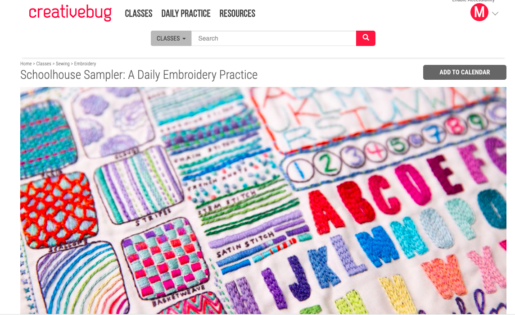
Waaay back in early March 2020, in the last gasp of the Before Times, Rebecca Ringquist of Dropcloth Samplers mentioned she was looking for test stitchers for a sampler to be used in her upcoming Creativebug class. I love Rebecca’s samplers and had taken several of her other Creativebug classes, so I was delighted to be chosen as one of the stitchers on this project.
Although we had never met, I knew Rebecca lived in my corner of Portland. She left the sampler on my porch one day, but I wasn’t home. Remember not being home? That day seriously was one of the very last times I wasn’t at home for a year.
The second-to-last very last time was March 10th. Even though my nose was still recovering from a harrowing-if-fascinating surgery to remove skin cancer, I went to the Tuesday night singalong of my beloved Low Bar Chorale. On my way into Show Bar at Revolution Hall, I passed some women sitting at one of the patio tables—and did a double-take, because I recognized Rebecca!
I think I sort of shrieked at her? I’m excitable that way. I introduced myself and we had a good laugh about it. She thanked me for testing the sampler and I told her I was already having a fabulous time with it. Then we went inside and sang with the band: a roomful of joyful adults shoulder to shoulder, mouths wide open, masks undreamed of.
Rebecca started a group text with her four test stitchers, and we spent the rest of March and April adjusting to lockdown and finding ourselves with LOADS of time for embroidery. Our deadline was late April, because Rebecca was supposed to film in May, I think. I loved working on the sampler, especially the alphabets. When Rilla saw the palette of floss colors I’d chosen, she laughed—they’re the same hues of Prismacolor pencils I always wear to a nub.
Covid, of course, changed Rebecca’s plans to fly to Creativebug’s studios in 2020 and film the class. But this year she was able to go at long last, and her class—Schoolhouse Sampler: A Daily Embroidery Practice—will begin on Saturday, aka January 1, the best day of the year.
(I love love love me a fresh start.)
The Schoolhouse Sampler is available at Rebecca’s Etsy shop, and you can sign up for the class at Creativebug. I’m a Creativebug affiliate, but I’m also a longtime subscriber, as you probably know if you’ve been around Bonny Glen for any length of time. It’s where I learned how to draw!

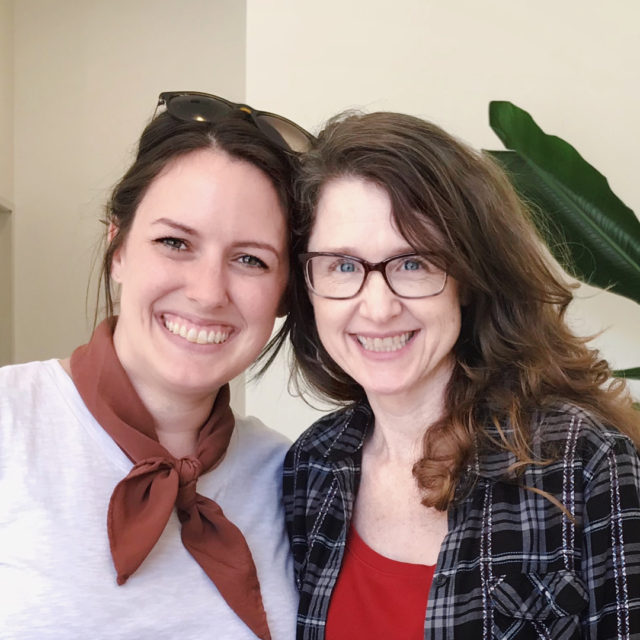

So here’s a fun thing: I got to take a watercolor class last Saturday. If Peggy Dean offers a workshop in your town, jump at the chance to take it! Three hours passed in a flash as we learned watercolor techniques for leaves and loose florals. Such a blast. And the paints she sent us home with—more swoon. Plus one of her cruelty-free, eco-conscious brushes. We laughed and painted and learned cool stuff (with a brief, blissful interruption to take turns petting the ADORABLE King Charles spaniel puppy who appeared in the tea shop with his very accommodating owner). Peggy’s teaching style is A+++ and I had a wonderful time sharing everything I learned with Rilla at our Saturday Night Art Date afterward.
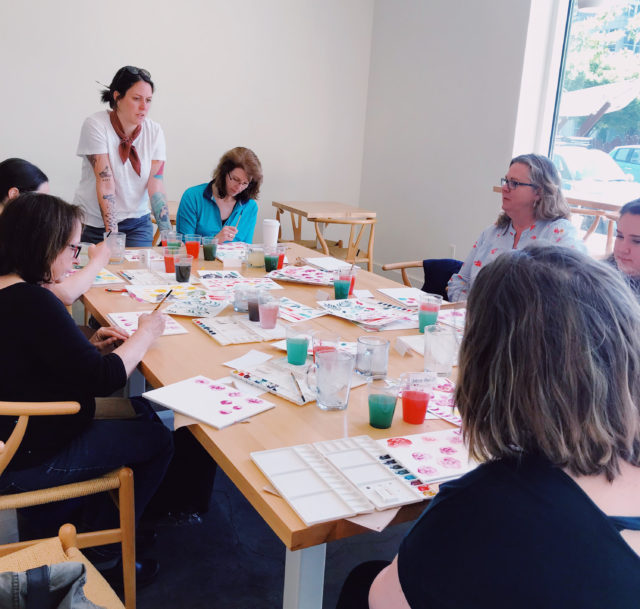
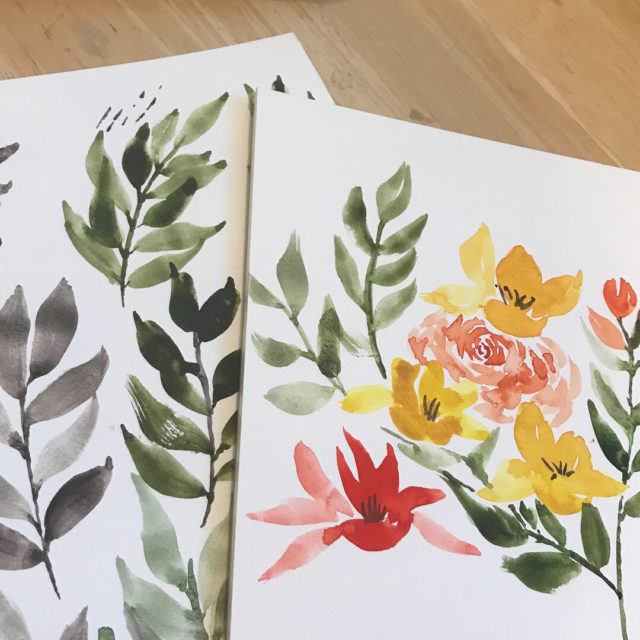
If you can’t get to a workshop, Peggy’s Skillshare classes are also excellent (Rilla and I have taken several) and you’ve heard me praise her Botanical Line Drawing book many times before. I’m glad I’m a homeschooler because I can decree next week to be take-all-the-rest-of-Peggy’s-classes week if I feel like it. If you’re new to Skillshare, you can get two free months of unlimited classes. (Also highly recommended: Stephanie Kilgast’s Sculpey classes.)
Thank you Peggy for a fabulous workshop! I’m still swooning over that hematite violet. 😍
December 16, 2016 @ 5:15 pm | Filed under:
Art 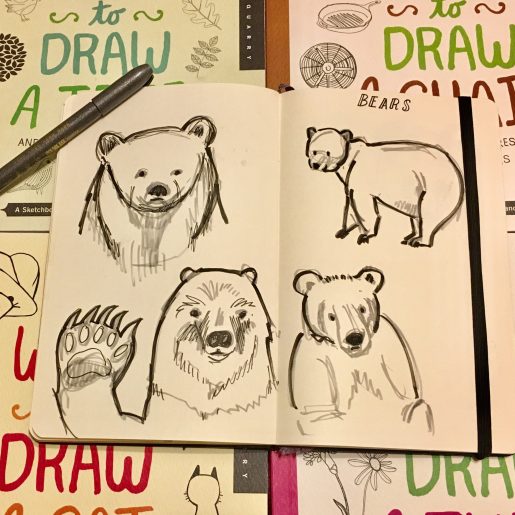
In a comment on yesterday’s “inside my pen case” post, Hanni wrote:
I have loved watching your journey of learning to sketch and draw. I want to start myself but I’m nervous. Have you always been a person who doodled etc? Or did it start when you made it a goal to sketch everyday? Seeing if there is hope for a person like me who has never done it naturally but has always been inspired by others.
I answered with a long reply, which I’ve decided to pull into its own post here. Tl:dr version: If I can do it, anyone can.
Hanni, start, start!!! I wasn’t a doodler before…I used to try to draw as a kid and was always so frustrated by my inability to make anything look the way I wanted it to. In college I took a costume design course that included a brief unit on Drawing on the Right Side of the Brain. That book blew me away. And in doing those exercises in class, I was astonished at how much better I got, and how rapidly. But then I dropped it again…for over 20 years.
I started this daily practice with Lisa Congdon’s line drawing class at Creativebug in fall 2014. From there I jumped to Sketchbook Skool and was really inspired and energized by those classes. Or—I guess actually I started with a Creativebug class on art journaling with Dawn DeVries Sokol* before the Congdon line drawing class, and I liked that one but found that what I really wanted was to learn to draw (vs art journaling which I always admire when I see other people’s but don’t seem drawn to in my own practice).
Since then, Creativebug has added SO MANY great drawing classes (all for your $5/mo subscription). I especially like the ones that are Daily Drawing Challenges because they walk you through how to draw specific things. (I’m currently obsessed with spatulas. Don’t ask me why. Just something really satisfying about that shape, LOL.)
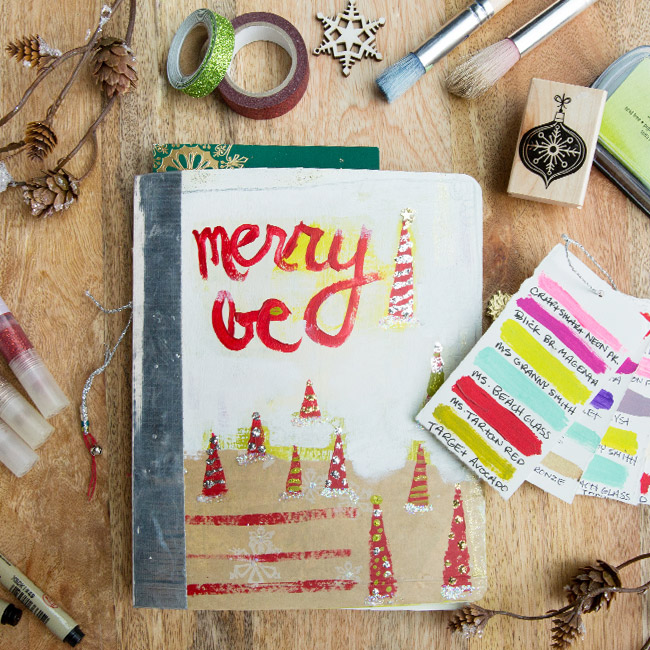
*Dawn Sokol has a new Holiday Art Journaling class at Creativebug that Rilla and I will be checking out on our next art date, because art journals are absolutely my daughter’s cup of tea. (Affiliate link.)
For dipping your toes in without spending money, I would recommend trying out some of Koosje Koene’s free “Draw Tip Tuesday” videos on Youtube. So good and totally doable. Search YT for them and then maybe scroll back to some earlier ones and work forward. You’ll see that a lot of the stuff in my sketchbook comes from Koosje’s lessons.
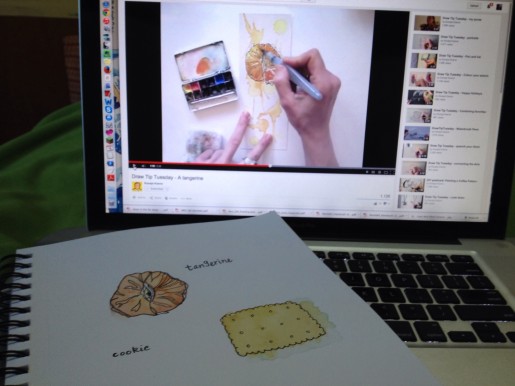
Other good online instructors are:
Jane LaFazio, Liz Steel, and Roz Stendahl. I encountered them all via Sketchbook Skool first. Then Jane came to San Diego for a one-day workshop version of the nature journaling/watercoloring class she offers online, so I signed up for that. And oh my! So awesome. Here’s a post with some photos of the work I did in that class.
Liz and Roz are both gifted instructors. Their online classes are video-based and include extremely detailed PDF handouts to download.
Backing up to your question: Honestly, I don’t have natural drawing talent. I think in words, not pictures, and I can’t just sit down and draw something out of my head and have the angles and shapes look right. I’m frustrated a LOT of the time by my shortcomings. But natural drawing talent isn’t required to be able to *learn* to draw. If you can sign your name, you can already make all the basic shapes that every single drawing is composed of. That was one of the Drawing on the Right Side of the Brain revelations that floored me, way back when. Anyone can learn.
Danny Gregory (the other co-founder of Sketchbook Skool along with Koosje) makes a distinction between small-a art (which we can all make) and capital-A Art (you know, museum stuff). 😉 I’m not striving for Art, just art. My sketchbook journey has made me really happy. About every ten pages I draw something I actually like. 🙂 And you know what, for now that’s plenty. I usually mess up the page with something else, but sketching is something I do that truly is about process, not product. The pens and paints feel so good in my hand. Mark-making, color-swirling—it’s incredibly satisfying.
And I like having this thing I do that is purely about personal satisfaction. Writing is the Thing I have always done, the Thing that defines me—and because I’m good at it, it’s the Thing I do for a living. Which…puts you in a different relationship with the Thing. If that makes sense. Sketching owes me nothing, and I owe it nothing. No demands beyond the easy five-minutes-a-day minimum I impose upon myself. Most days, it’s much more than that, because once I get sucked in, I never want to start.
I often yearn for a better eye, a stronger and more original sense of artistic vision in my work (like the brilliant creative vision I see manifested in the work of the sketchbook artists I admire on Instagram), and as I said I get plenty frustrated with my fumbling, my un-originality. But that’s all before and after the fact. DURING, when the pen is in my hand, all of that drops away and I experience the pure, absorbed joy of mark-making. That’s what keeps me at it, not a sense of progress (although when I look back, I can see that I have improved).
I hope you’ll dive in! Let me know if you wind up taking any classes…

A last thought. When I began taking online classes, I found that many instructors speak very strongly against sketching in pencil, on the grounds that it makes beginners too fussy, too prone to erase. I will say that while I understand that thinking (and do a fair amount of sketching directly in ink myself, because I’m addicted to pens), for me that advice was a misdirect. I spent about eighteen months obediently eschewing pencil before I had a light bulb moment of: oh wait, I love how pencil feels going on the page. And boom, just like that, things opened wide. I love pencil sketching and then putting ink over it. That suits me really well. Diminished a lot of my frustration over ‘ruining’ things because it takes me a few tries to get the shape right. And I just plain like the texture! It’s funny that with everything else in life (homeschooling, ahem) my entire approach is: take what works and do my own thing with it, but with drawing I was quite cowed by authority at first.
I’ll close with some books Rilla and I have enjoyed working from, these past two years. When I’m stumped for material, I pull out one of them and tackle a page.
20 Ways to Draw a Tulip and 44 Other Fabulous Flowers
20 Ways to Draw a Cat and 44 Other Awesome Animals
20 Ways to Draw a Tree and 44 Other Nifty Things from Nature
20 Ways to Draw a Chair and 44 Other Interesting Everyday Things
Illustration School: Let’s Draw Cute Animals
Illustration School: Let’s Draw Happy People
Illustration School: Let’s Draw Plants and Small Creatures
















Practical inspiration from Danny Gregory:
Art Before Breakfast: A Zillion Ways to be More Creative No Matter How Busy You Are
The Creative License: Giving Yourself Permission to Be the Artist You Truly Are




Rilla and I are looking forward to working through this book together: Draw Every Day, Draw Every Way (Guided Sketchbook): Sketch, Paint, and Doodle Through One Creative Year by Jennifer Orkin Lewis (AugustWren on Instagram—my fave!). This is one of those books you’re meant to and paint directly in, and I’m excited to think we’ll be creating a little archive for ourselves of our shared sketchbook journey. She’s been my staunch companion every step of the way, so far. Danny and Koosje and Roz are the superstars of Rilla’s world.


(Jennifer Lewis also offers a wonderful course on painting with gouache at Creativebug, as well as a Daily Painting Challenge. I’m making slow progress through both, because gouache takes a bit more planning for me than just reaching for my watercolor palette, but these are marvelous classes.)
Related posts:
• Daily Creativebug Challenge
• Drawing It Out (2005 post that, like this one, reminisces about that costume design class and the Edwards book, but then focuses on the how-to-draw books my older kids loved in those days. It’s funny to reread it now and see that despite its “anyone can learn to draw” message, I wasn’t striving in that direction at all myself. I talk about being able to draw a tree, a cartoon giraffe, and an alligator. That was the full extent of my doodling repertoire at the time and in this post, I don’t seem to express any intention to move beyond that. I’m sure it’s no coincidence that at the time it was written, I’d had four babies in ten years and was expecting a fifth.)
• Notebooks and sketchbooks and planners, oh my!
• 2015, Year of Paper
• Planner Love
• Notebookery
• Unearthed: the Notebooks
• Ten Ways to Cultivate a Family Art Habit
• My interview with Danny Gregory about raising creative kids
• Learning in Public
One of the earliest lessons of having a special-needs child was learning to recognize his progress not by comparing him to typically-developing children of the same age, but by comparing him to his own earlier self. I say ‘lesson’ and ‘learn’ but in truth this was something that happened naturally and almost instantaneously after his multiple diagnoses and the beginning of various therapies—physical, occupational, speech. As soon as I had an understanding of his developmental challenges, I was able to rejoice over each increment of progress, each small accomplishment along with the big ones. It was like my brain was wiped free of comparisons to other babies, including my first three, and all that existed was this baby, making these tremendous (even when tiny) strides.
That mental shift keeps popping into my mind lately as I keep working (and working and working) on drawing. Only here, it isn’t natural and instantaneous. Here, I have to keep relearning the lesson; some days I practically have to shout it at myself. The trouble, of course, is that I have so many friends who are spectacularly good artists. Years of training, years of dedication and work. Hundreds or thousands of pages of finished art under their belts. If I compare my drawings—or my slow progress—to them, I feel bleak. I don’t have it, that thing they have. Vision, natural talent, hand-eye coordination, vast knowledge of technique—you name it, I don’t have it. All I have is…earnestness. A belief that everyone can learn to draw, and that includes me. And this long-simmering desire to learn, kindled last fall into a full-boil determination.
So I keep reminding myself, baby artist, to compare myself to the even babier artist I was a few months ago. I remember when my son was finally able to climb up stairs on his own. He was well past a year old. He had motor planning issues, and we spent hours and hours over a period of several months, moving his limbs for him up stair by stair by stair. Hand, knee, hand, knee. Or was it hand, hand, knee, knee, I don’t remember now. Either way, it took so much practice. Until one day his brain figured it out. The pattern was learned. The pathways were formed. Soon after that we could hardly remember what it was like before he learned to climb stairs. We had to scramble to help him learn how to climb down.
Stair by stair, I’m making progress. For every ten drawings I hate, I make one that I like. But I like looking at the bad ones, too, because I know that the fact that I can see what’s wrong with them is another sign of my progress. My eye is improving along with my hand. (“Your taste is killer. Your taste is why your work disappoints you.”)
Today I looked at something I’d done, a couple of quick, surreptitious gesture sketches of some women in a meeting, and realized I’d attempted people—in complex postures, no less—without even thinking about it. Six months ago, I wouldn’t have done that. It’s nice to know I’ve made it up a stair or two.
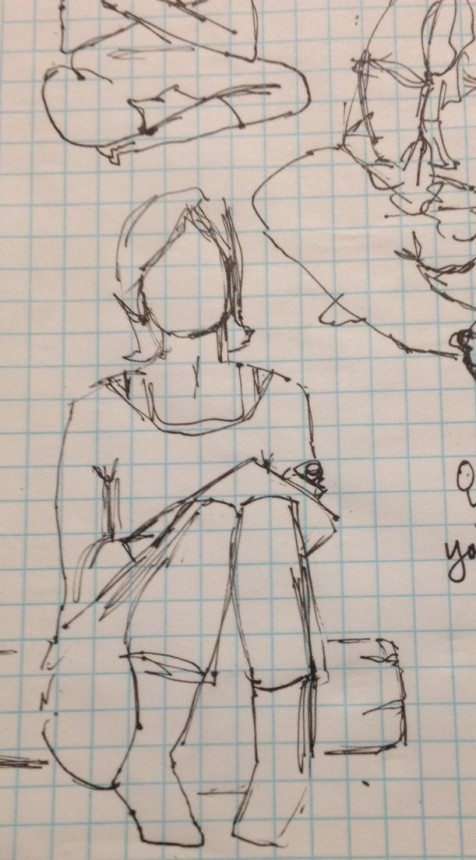
February 16, 2015 @ 9:28 pm | Filed under:
Art 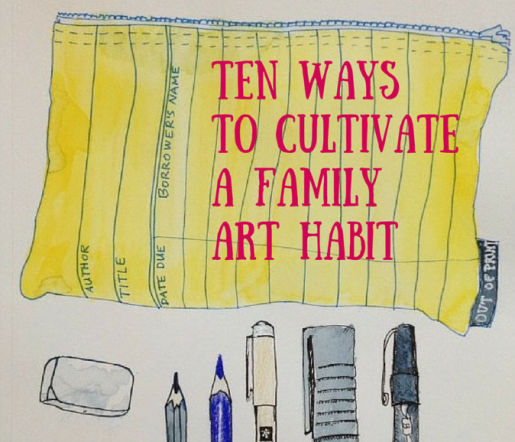
On Twitter, Kim asked if I had any advice for a family getting started with sketching and art journaling. Did I ever!
I’ve Storified the conversation, if you’d like to see how it unfolded, but I’ll recap it here as well.
My replies below, expanded a bit. Points #6 and 7 are the most important.

Suggestions? Yes, lots!
1) Koosje Koene’s Draw Tip Tuesday videos. She also offers classes in drawing and art journaling. (Here’s a post I wrote about her videos in November.)
2) Sign up for a free two-week trial at Creativebug and take Dawn Devries Sokol’s Art Journaling class and Lisa Congdon’s Basic Line Drawing. I wrote about how much Lisa’s class inspired me in my “Learning in Public” post.
3) A bunch of books to inspire you: Lynda Barry’s wonderful Syllabus; Danny Gregory’s new Art Before Breakfast (it’s a delight; I’ll be reviewing it soon) and the much-beloved The Creative License; the Illustration School series; the “20 Ways to Draw a…” series; Claire Walker Leslie’s Keeping a Nature Journal; the Usborne “I Can Draw” series. And a few more recommendations in this older post.
4) Maybe try a Sketchbook Skool course! They offer a free sample class (I mean klass) so you can get a taste of the magic.
5) Cathy Johnson videos. Rilla loves Cathy’s art and her gentle delivery.
6) The most important thing! Really just dive in and do it—if you do it, the kids will follow. Mine truly love to see me working & playing in my sketchbook. Actually, Rose was just commenting on it today, before this Twitter conversation occurred. She said she has really enjoyed watching me start from scratch (so to speak) and work at learning to draw. They all seem to love to see me trying, making mistakes, learning, improving. My progress excites them almost as much as it does me. 🙂
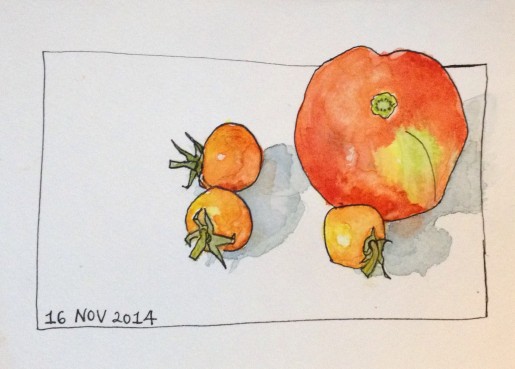
7) The REALLY most important piece of advice I can give: Allow plenty of TIME and room for mess. Many parents say “I want my kids to be creative” but can’t tolerate mess. Art is messy. Creativity is messy. You need space to leave work out and return to it. Supplies in easy reach. And big spans of time for messing around, staring into space, doodling, doing things that look unproductive. I can’t emphasize enough how important this is to any creative process. Time and room. (More on this in my post “Makers Gotta Mess.”)
When I’m writing a novel, my most intense work happens while I look like I’m doing nothing at all. Sitting and staring blankly, chewing my nails, or filling an entire page with tiny lines and spirals. This is my body getting out of the way so my brain can get down to the real work of creating.
And for the visual arts, these totally tactile pursuits, you’ve got to have a place to spread out your paints, your pencils, your small objects that make you itch to draw. You know what’s nice and tidy and doesn’t clutter a room? A cellphone. If you want them to spend less time staring at screens (I’m not knocking screens here, you know I love me some screen time), you’ve got to grant them some real estate.
With that in mind, I make a point of keeping art supplies in easy reach. We have a dedicated kitchen drawer for placemats, paper, paint supplies so even the youngest kids can help themselves. Jars of colored pencils & crayons on table, a sharpener on the kitchen counter, a stack of art books on the shelf nearby. I want them to have constant free access to art materials. It’s also a good idea to keep a bag packed for outings. I described ours in this old GeekMom post.
8) And what materials do I recommend? For littles: good paper, cheap paints. I elaborated on my reasons in this post from several years back:
When my older kids were little, I read lots and lots about the benefits of providing children with really high quality art supplies. In some cases, I still agree: Prismacolor colored pencils are worlds better than your drugstore variety. The lead is so creamy and blendable. They’re expensive but they last a long time—we’re on our second set of 72 colors in over ten years.
But watercolors? Real watercolor paper makes a huge difference, but it’s expensive; that’s one reason I was so taken with Jenn’s idea to cut it into smaller, postcard-sized pieces. But when it comes to the paints themselves, well, I’ve been the high-quality route, absorbed the persuasive literature that talks about rich pigments and translucent hues; bought the pricey tubes of red, yellow, blue; collected jars for mixing colors; watched my children squeeze out too much paint and gleefully swirl it into an expensive puddle of mud-colored glop.
Lesson learned. The 99 cent Roseart or Crayola sets work just fine. In fact, dare I say I think my preschoolers like them better? Mixing colors is fun, but there is nothing quite so appealing as that bright rainbow of pretty paint ovals all in a row. When Wonderboy and Rilla make a mess of their paints, Jane cleans them up with a rag and they’re practically good as new.
For older kids—and for yourself!—my advice is to skip the student-grade watercolors and go right to artist quality. More expensive but the difference is immense. You can use the money you saved buying cheap paints for the preschoolers. 😉
We’re still addicted to Prismacolor pencils—no other brand will do for me. And I like Micron pens for line drawing. The ink is waterfast so you can paint over it (like my pumpkins in yesterday’s post). I also picked up a few gel pens—white, silver, and gold—and Rilla has had unbelievable amounts of fun with them. I love the white one for writing on a dark surface, like on the tag of my pencil pouch here.
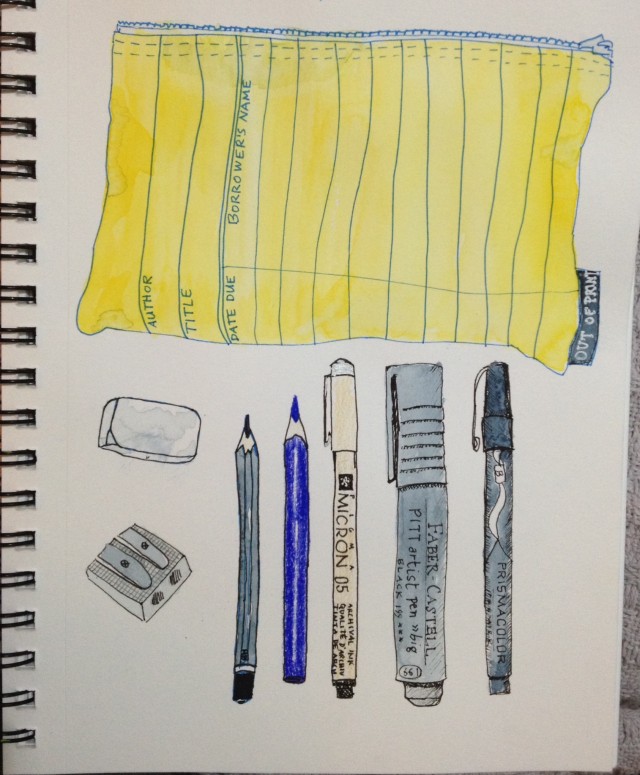
Don’t feel like you have to have millions of fancy supplies right off the bat. Look at what Andrea Joseph can do with a simple Bic pen. (Seriously, this blew my mind.)
The sketchbook I just filled up was a Canson Mixed Media, 7×10 spiral bound. The size worked really well for me and the paper takes watercolor okay (not perfectly but well enough for where I am right now). I also have a small Moleskine journal with watercolor paper, but it feels so special I find myself hesitant to use it and reaching for the mixed media book instead. (I’ve just started a new one, same as the one I filled up.) That’s my real playground, the place I’m not afraid to (in the words of my personal hero, Ms. Frizzle) “Take chances and make mistakes!” But I’m getting braver every day and the lovely paper in that Moleskine is calling to me.
I’ve also found I love doing my first rough sketches with a brown watercolor pencil, very lightly. I go over it with ink afterward and then, when I paint, the pencil just blends in and becomes shadow. I don’t sketch this way every time, but for some reason it seems to free me up. I’m more daring with this pencil. It takes me to a confident place between graphite pencil—with its sometimes overly tempting eraser—and straight-to-ink, which is sometimes exhilarating and sometimes terrifying. The brown Aquarelle feels like my co-conspirator. I don’t know how else to describe it. I have even starting making some first tentative stabs at portrait drawing, thanks to this pencil. (I tried a selfie-a-day project for a week. None of them looked much like me, but this attempt on day seven could maybe be a cousin?)
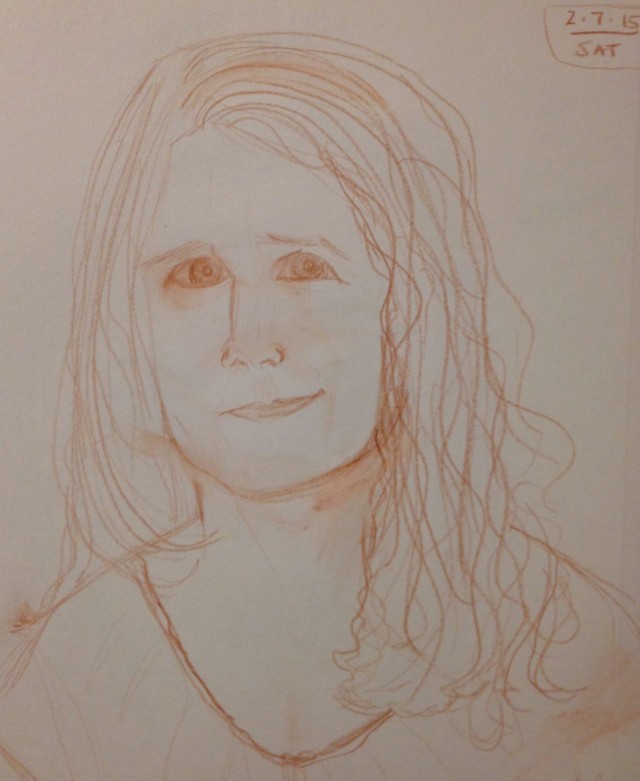
Guys, I still feel so shy about posting my drawings! I mean, I have so many friends who make their livings as illustrators—heck, one of them even just won the Caldecott! (GO DAN! SO THRILLED!) Do you know how nerve-wracking it is to know pros are looking at your rookie work? Of course you do. Because what I’ve learned is everyone feels that way. Even my most brilliant artist friends look at some other person’s work and sigh wistfully, wishing they’d made that piece. I’ve seen it happen time and again. So bit by bit I’m getting brave enough to share my baby steps.
9) Okay, so you have your lovely sketchbook and drawing implements, now what to draw?? Well, I guarantee Koosje Koene’s videos mentioned above will keep you and the kids busy for a good long while. There’s also this wonderful Everyday Matters Challenge list at Danny Gregory’s blog. 328 suggestions, so you’re just about good through 2016. And Kortney tipped me off to this most excellent Lynda Barry post (in Rilla’s words, I simply adore her) about keeping a visual diary.
10) And a last tidbit I almost forgot: A most beloved activity here (especially for Rilla and me) is to listen to audiobooks while sketching. Many of my happiest hours have been spent this way. We’re especially fond of Roald Dahl while drawing. Nobody brings on the whimsy like Dahl.

November 24, 2014 @ 8:56 pm | Filed under:
Art 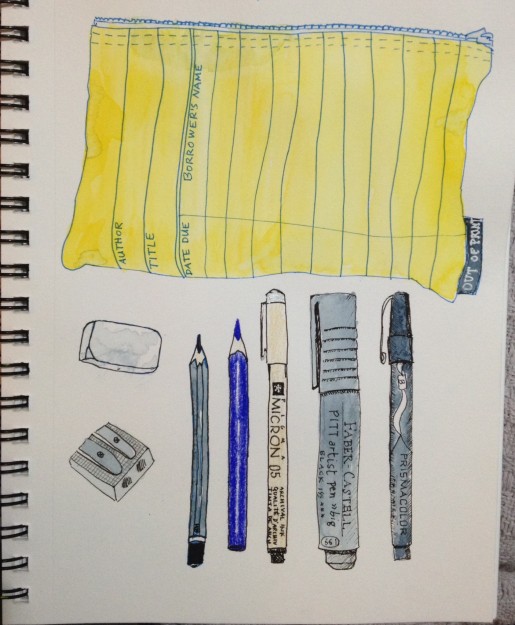
Something I think is wonderful about social media is the way so many creative people share their efforts and progress in various arts. I don’t just mean professional artists sharing their finished work, though of course that too is a great delight—this abundance of gorgeous, polished photography and painting and stories and poems and quilts and handwovens and other creations we find displayed all over the internet. Just Google artist sketchbook blog and you could be absorbed for weeks upon weeks.
But even more so, I appreciate the working-it-out pieces, the I’m-undertaking-something-new-and-here’s-how-it’s-going-so-far posts. Years ago, a bunch of us were doing this with quilting—posting pictures of our blocks, sometimes the first ones we’d ever made, crooked seams and all. You see it often with knitting and sewing and all kinds of handcrafts. Look what I made! I know it isn’t perfect, but… Sometimes shy, sometimes fearless, always inspiring, this sharing of incremental progress.
Even people who are accomplished in one aspect of an art sometimes do what I’ve come to think of as “learning in public” when they undertake another aspect of it—a kind of unabashedness I thoroughly respect, since it means admitting to gaps in skills or knowledge, but speaks to a desire to always be learning, always be stretching one’s abilities. I think about the very wise advice of that great sage, Ms. Frizzle: “Take chances! Make mistakes!” Our mistakes are what spark growth.
Certainly you may challenge yourself in private, and do plenty of chance-taking and mistake-making without an audience. Most people do, I think. Or they do it in the context of a relatively intimate setting: a knitting club, an improv class, a private piano lesson. I understand that, I respect that desire for privacy. But it makes me all the more grateful to see someone willing to fumble along in public, so to speak, encouraging the rest of us by posting rookie work online. Then, too, you create an archive of progress, not just for yourself but for future students of the art.
Lisa Congdon, a very accomplished artist, decided to improve her lettering skills by posting a handlettered image on her blog every day for a year. Every day of 2012, she shared her work. About a hundred days into the project, she wrote:
Hand lettering everyday is a lot more challenging than I thought it would be. Some days it feels really fun. Some days it feels like a chore (and I have to redo something 5 times to get it as right as I can). I do like the discipline of the process. When I did my first daily project in 2010, I felt the same way. The daily encouragement from people who read my blog and follow me on twitter also helps tremendously!
Artist Jennifer Orkin Lewis (I’ve posted about her before) does a daily 30-minute painting in her sketchbook and posts each page on Instagram. They are a feast for the eyes, let me tell you. In an interview with Lisa Congdon, Jennifer said, “I decided to post them all on Instagram to hold myself accountable to painting everyday.” I think there’s a lot to be said for using a blog or other public medium to help yourself stick to a goal—spurred on both by the sense of accountability Jennifer describes, and the encouragement and support Lisa speaks of.
***
I wrote the above more than a week ago and left it sitting in drafts because—despite everything I said up there—I personally feel really shy about sharing my rookie drawing and painting efforts. (Confession: the one time I went to a karaoke party, I was dying to get up and sing—and would have died before I’d have volunteered.)
This morning Tammy Garcia posted the following at Daisy Yellow:
When I started drawing I didn’t know that I would or could get better. I thought that people were either born with innate drawing talent or they were not. Perhaps they skipped the queue. But the truth for me has been that my coordination and control have improved over the years. If you are having trouble getting the pen to do what you want it to do. Maybe you just need to draw more lines.
When I started drawing in about 2008, I was an accountant – a financial analyst – with no particular drawing skill set. I started drawing doodly lines simply to pass the time while my kids were doing stuff. I drew in moleskine journals. On airplanes, at swimming lessons, while the kids splashed in the tub, at Starbucks and book stores.
The boxes looked like wonky kites. Parallel lines intersected instead. Circles looked like cracked eggs.
But looking back, I can see that every time I challenged myself to try something new {what about a mandala without any curved lines? what about ivy leaves that cover each page? what about a mandala where the lines focus on negative space? what about a new alphabet?} I made a step forward. In understanding, in pen control, in art. With trial & error & practice, I now know how hard to press, how to move my arm, my hand, to get a reasonable facsimile of a straight line. I can draw curves. I still can’t draw great faces, but I believe that one day I will.
(Read the rest—there’s a lot more including a list of ways to improve your line work.)
Tammy teaches online art classes and sends out regular art-journaling prompts that inspire masses of people. What a delight to see her discussing her (relatively recent) learning curve. I was nodding excitedly as I read along, because I’ve been drawing lines almost obsessively ever since taking Lisa Congdon’s Creativebug course in early October—pages and pages of scallops or triangles or short parallel lines in interlocking patterns. It’s meditative and relaxing, a good busying-of-the-hands for me when I want to think for a bit. But mostly I’ve been doing it simply for the pure pleasure of feeling the line. Of making my pen do what I want it to do. Of figuring out, bit by bit, how to do it better.

Now Rilla and I are watching all these Koosje Koene drawing videos and I’m trying to push a little farther. This month my sketchbook is full of staplers and tape dispensers and colored pencils—whatever’s lying around on my desk when I sit down to draw. I’m working on watercolor, too. SO MUCH TO LEARN. Scott gets cross with me when I start pointing out all the flaws in my work—he thinks I’m way too hard on myself, being a novice and all—but I remind him that as professional writers, our entire day is laced with editing and revising—the constant practice of seeking out places in our writing that could be made better, stronger, zingier, lovelier, fresher, truer, something-er. I don’t feel pained about cataloguing the ways a drawing isn’t there yet. I enjoy it, actually. Especially since reading that Ira Glass quote and recognizing that it’s my “killer taste” that allows me to see the weaknesses in my own work.

Because at the same time that I’m self-critiquing, I’m also feeling a tremendous sense of pleasure in having a Finished Thing I Made. This was a bit of a revelation I had the other day after I painted these tomatoes from my garden. It’s my first real attempt at a proper watercolor. And even as I was scrutinizing its shortcomings, I felt giddy: there it is. This thing I made. In one sitting! I’ve been working on my current novel for four years. Even books I’ve written quickly took months—and then another year or more to reach publication day.
I can grow a tomato in my sketchbook in an hour. To me it feels like magic.
I don’t think I’m brave enough to commit to posting a daily drawing—much as I would like the accountability and encouragement! But maybe I’ll try to keep learning in public once in a while. Something I want my kids to know is that you have to be not-great at something on your way to getting better at it.



























